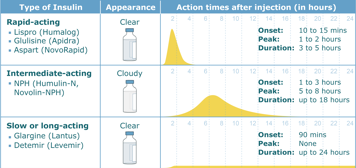Where does injectable insulin come from?
Insulin was first isolated and collected from the pancreases of cows and pigs for use in humans with diabetes. Since 1983, however, a product called biosynthetic human insulin has been available. This insulin is produced in a laboratory by introducing a man-made human gene into bacteria or yeast. This process produces insulin that is almost exactly the same as that created in the human pancreas.
Through further changes, man-made altered forms of insulin (called insulin analogs) differ from naturally incurring insulin by having different action times. Today, all children and nearly all adults with diabetes receive biosynthetic human insulin products and insulin analogs.
Insulin strength and packaging
In North America, insulin is usually produced at a concentration of 100 units/mL. Before giving insulin to your child, make sure to check the concentration. Insulin is available in three ways:
| Vial |
Cartridges | Preloaded disposable pens |
|---|---|---|
|
|
|
 |
 |
 |
Insulin action times
Insulin analogs are generally described as:
- rapid-acting (also referred to as fast-acting)
- intermediate-acting
- long-acting.
Insulin analogs are also described according to their course of action:
- Onset is the time it takes for the insulin to start working.
- Peak describes the period when the insulin is working at its strongest.
- Duration describes the length of time before the effect of the dose wears off.

Premixed insulin
Insulin is available in premixed doses that combine rapid-acting insulin with intermediate-acting insulin in fixed proportions. Premixed insulin is generally not recommended for children, because it does not allow for any flexibility in insulin dose adjustments and, therefore, does not allow for better blood sugar control compared to other insulin routines.